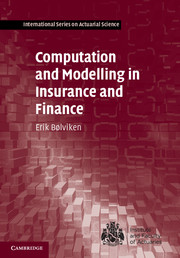Book contents
- Frontmatter
- Contents
- Preface
- 1 Introduction
- PART I TOOLS FOR RISK ANALYSIS
- 2 Getting started the Monte Carlo way
- 3 Evaluating risk: A primer
- 4 Monte Carlo II: Improving technique
- 5 Modelling I: Linear dependence
- 6 Modelling II: Conditional and non-linear
- 7 Historical estimation and error
- PART II GENERAL INSURANCE
- PART III LIFE INSURANCE AND FINANCIAL RISK
- Appendix A Random variables: Principal tools
- Appendix B Linear algebra and stochastic vectors
- Appendix C Numerical algorithms: A third tool
- References
- Index
4 - Monte Carlo II: Improving technique
from PART I - TOOLS FOR RISK ANALYSIS
Published online by Cambridge University Press: 05 May 2014
- Frontmatter
- Contents
- Preface
- 1 Introduction
- PART I TOOLS FOR RISK ANALYSIS
- 2 Getting started the Monte Carlo way
- 3 Evaluating risk: A primer
- 4 Monte Carlo II: Improving technique
- 5 Modelling I: Linear dependence
- 6 Modelling II: Conditional and non-linear
- 7 Historical estimation and error
- PART II GENERAL INSURANCE
- PART III LIFE INSURANCE AND FINANCIAL RISK
- Appendix A Random variables: Principal tools
- Appendix B Linear algebra and stochastic vectors
- Appendix C Numerical algorithms: A third tool
- References
- Index
Summary
Introduction
With the exception of Section 4.2, and the first half of Section 4.3, the material of this chapter isn't much used elsewhere and can be skipped at first reading. Yet it would be regrettable in a book of this kind to stay solely with the very simplest of Monte Carlo. Specialist books in finance are Jäckel (2002), Glasserman (2004) and Dagpunar (2007). Most of their illustrations are from short-term finance and, it seems useful with a text more adapted to the needs of actuaries, with examples from general insurance too.
We shall start with table look-up methods in the next section. These are not always mentioned, yet they possess very useful qualities. They are general (can virtually always be used) and are ultra-fast once they are in place. With Poisson or multinomial sampling these are the methods of choice when there are very many repetitions. At the expense of some discretization error, continuous distributions can be handled too. The restriction of table methods is one of dimensionality. We must be able to break simulation down on independent variables or, at most, a handful of dependent ones. When that is impossible, Markov chain Monte Carlo is another general approach; see Section 4.8.
The other methods (Sections 4.3–4.6) are specifically geared towards speed enhancement, sometimes achieving drastic improvement.
Information
- Type
- Chapter
- Information
- Computation and Modelling in Insurance and Finance , pp. 97 - 137Publisher: Cambridge University PressPrint publication year: 2014
